Hello everyone! I apologize for the nearly three week pause in posting. All of you who are fellow academics understand how crazy the end of the academic year is, and I also made my annual summer migration to Lyon, arriving a week ago today.
This post is once again far too large for email with all of the photos, but I’ve learned that if you click on the title of the post above you will be taken directly to the web version.
Two weeks after visiting Bologna I passed through it again on the train, on my way to the Adriatic coast. My main goal was to visit San Marino. Like many geographers, I have a list of countries visited so far and the desire to visit as many as possible.
Most of the countries that I’ve already visited are in Europe: countries are small here, the size of states in the US, and you don’t have to travel very far to cross into a new one. You do, however, have to go out of your way to get to some of the very tiny ones, the microstates: Andorra (in the mountains between France and Spain), Liechtenstein (in the mountains between Austria and Switzerland), Malta, Monaco, San Marino, and Vatican City. After my visit to San Marino, I’m only missing Liechtenstein and Malta.
The least expensive way to get to San Marino is to take a bus from Rimini, an ancient city on Italy’s east coast that is famous today for its beaches and nightlife. The beaches were completely empty on a stormy day in late September.
I had a lunch reservation and several hours before and after lunch for walking around the city. I learned that the famous film director Frederico Fellini was from Rimini. This enormous camera is at the entrance to a city park dedicated to him. It reminded me of the Nikon FE2 that I carried everywhere in high school, all day, to every class and event as the yearbook photographer.
My career plan was to be a photojournalist, or more specifically a photographer for National Geographic. As a first-generation college student, it never occurred to me that a major in photojournalism might not be available the college I chose, Macalester, and I ended up majoring in geography instead. But here I am 35 years later doing a kind of photojournalism after all, albeit for a small (but growing!) audience.
Rimini was founded by the Romans as Ariminum in the third century BCE. Here is a map of what it looked like at the time:
The remains of the entry arch on the right side of the map are still in place, and the entire bridge on the left side is still intact and fully functional.
Walking across a bridge that is 2500 years old is not unusual for Italians, but from my American perspective I still find it amazing.
I headed toward my lunch reservation at a restaurant called Io e Simone.
I don’t think I’ve explained how Italian menus work yet, and this seems like a good opportunity. The centerpieces of the meal are the primi and secondi, which translate as “firsts” and “seconds,” served and eaten in that order. Every meal that I had with Italian families during my several months of woofing in Italy included at least these two components. Primi are starchy dishes: often pasta, but it could also be risotto or a soup fortified with beans, pasta, or some other starchy component. The secondi are the proteins, usually beef, pork, chicken, or fish. Historically the proteins would have been more scarce (or nonexistent for some families), so the primi are meant to fill your stomach so you can savor and appreciate a smaller amount of meat or fish. Italians that I’ve observed eating in restaurants usually order both a primo and a secondo.
Almost all menus in restaurants also include antipasti, literally “before pastas,” basically appetizers. If you’re already ordering the two “main” courses, you have to be more hungry than usual to include one of these, or plan on sharing it. Contorni are the side dishes, usually served with the secondi. When you order a meat course in Italy, you get just the protein on a plate – it doesn’t come with sides, so you order them separately if you want potatoes, vegetables, etc. Dolci are the desserts, and then of course there is a beverage part to the menu as well. Depending on the restaurant, there may be other categories like pizzas, panini, or “from the grill” (Dalla Griglia) like the menu from the restaurant I went to in Rimini. Their current menu is here, and I think it would be interesting for you all to explore it with me.
The Antipasti available are (in order) trout tartare (tartare always means raw) with an orange and ginger mayonnaise, salt cod (baccalà) in meatball form with Greek yogurt and lime, crunchy egg with zucchini flower, beef tartare, capaccio (thinly sliced raw beef) with a cabbage salad, and three different options for sliced charcuterie boards.
I was very curious about the “crunchy egg” so I chose that one, and it was delicious.
The zucchini flower was flattened, battered, and deep fried. There was a delicious mix of sauces at the bottom of the plate, one creamy and the other like an intense pesto. And then there was the surprise and mystery of the egg itself, soft-boiled but then also rolled in breadcrumbs and deep fried. I looked up recipes later, and that’s exactly how you do it, but I don’t think I have the delicate touch that it would take to peel a soft-boiled egg without breaking it.
The Primi on this menu (returns to the same link if you’ve closed it) are all pasta dishes. The first three are long pasta shapes (like spaghetti) with various sauces, the next two are stuffed shapes (like ravioli), and the final two are short pasta shapes (like penne).
Italy has thousands of varieties of pasta. It would be impossible to try them all, even more so than tasting the approximately 1,200 types of cheese in France. Every region has a handful of local pastas that are well known though, so when I see them on a menu I do try those. I ordered the pasatelli with clams, an option that is no longer on the menu – not surprising since it has been eight months.
Passatelli are a specialty of the region (Emilia-Romagna), made with stale bread (in the form of crumbs), eggs, and Parmigiano Reggiano. I liked them, but I found the dish more filling than a regular pasta and I began to regret having also ordered a secondo.
It took me a long time to decide what I wanted for my protein course. I was torn between something from the grill or a traditional secondo. The Dalla Griglia options on the menu are fascinating: young rooster, steaks from young heifers, deer, and veal are the first five options. Underneath the part in all caps, which says “selection of rib eyes, subject to availability,” there is donkey and then five different specific breeds of beef cattle from Bavaria, Iberia, Prussia, Italy, and Ireland. The traditional Secondi on the menu include tuna tataki, fried shrimp and calamari, rabbit, pork, lamb, and duck breast.
I decided on the fried shrimp and calamari because it also include “piccole verdure,” small vegetables. I thought I would get some vegetables without having to choose a contorno, and I did indeed get thin strips of carrot and zucchini – but they were also deep fried.
It was all delicious, but heavier than I was planning on. I had to ask for more lemon to cut the grease.
I was too full to even think about dessert. Already, this was one of the very few times that I ordered a primo, secondo, and something else, but I planned on this being my only meal of the day. Usually I order a primo and either an antipasto or contorno. You really can order what you want and in any sequence: sometimes I ask for a contorno as my appetizer, and a primo for my main dish, for example.
For the sake of completing an overview of the menu, the Contorni available are grilled vegetables, oven potatoes, caramelized endive with citrus (yum), sauteed chard and chicory, and roasted spiced tomatoes. The desserts are wild cherries with chocolate and mascarpone, a lighter version of crème brulé, fresh curd with strawberries, very thin pasta with two creams, a chocolate and coffee cream crumble, ricotta cake with fresh berries, and roasted pineapple with pomegranate, yogurt, and lime.
Notice the small note between the Contorni and Dolci that reads “coperto 3 euro.” The coperto is a per person charge for occupying the table, and it is almost universal in Italy. The injustice (in their eyes) of this charge just for sitting down drove my students crazy, even after I pointed out that there is no tax and no expected tip in Italian restaurants. If you order a pizza for 12 euros and a beer for 3, you pay 15 euros when you leave. The wait staff are paid minimum wage or more (unlike in the US, where they can legally be paid as little as $2.13 per hour), and they all have benefits and paid vacation. Like most civilized countries, the Italians don’t believe that a professional who works full time should have to rely on voluntary tips from customers to pay their rent.
Feeling very full, I continued my walk around Rimini. I saw this olive tree in the middle of a an intersection that is estimated to be 530 years old.
As the afternoon wore on, I started being incessantly bitten by small black flies – I was wearing capris and a t-shirt, with little means of defense. I ended up buying a second ticket for the earlier bus to San Marino, paying another 7 euros to avoid spending another 90 minutes with the biting flies.
From Rimini, the bus heads inland and then uphill, taking about an hour to arrive in San Marino. The principality is tiny, the same size as Manhattan, and is the fifth smallest country in the world. Vatican City is the smallest, at less than a fifth of a square mile. I had to plan my visit around the availability of the only place in the country where I could afford to stay, an AirBnB in Borgo Maggiore, just below the clifftop strip of land where the fortresses, bascilica, and seat of government are situated in the tiny capital city.
I was hosted by a lovely young woman originally from Russia who has been living in San Marino for eight years. I had the bedroom of her one-bedroom apartment, and she slept on a sofa bed in the living room.
I arrived at the end of the afternoon and at the start of a storm: it was windy, with heavy, dark gray clouds, and it was clearly going to rain soon. I was too impatient to wait for better conditions. A long set of stairs that began about 200 meters from the apartment led to the top, becoming much steeper and closer together in the second half of the 45-minute hike.
I took off my jacket, and I was the only person who was not bundled for the fall weather in long pants, jacket, and scarf. I got quite a few strange looks.
Thanks to the tempestuous weather, I had the site of the first tower to myself and was able to take a rare, people-free photo.
I walked to the second tower and back, then headed back downhill toward the apartment as the winds got stronger and colder.
The next morning I had a great breakfast provided by my host (muesli, banana, yogurt and coffee) and talked with her until she left for work. I also needed to work, and spent the next four hours grading.
I set out at around 1pm and hiked up the mountain again. Only after reaching the top, a 500-foot elevation gain, did I see the cable car that runs every 15 minutes for 3 euros. You can see the bright blue crosswalk near my apartment on the left side of the photo.
The city of San Marino, like so many small medieval cities, is almost entirely taken up now with stores and restaurants that cater to tourists.
Here though, in addition to the usual postcards, calendars, shot glasses, and so on, there is a thriving trade in guns and other weapons, electronics, leather goods, watches, cigarettes, and what I suspect are knock-off perfumes given the prices.
Since San Marino is its own country, they can sell tax free and duty-free goods. Andorra was similar, and like San Marino, most visitors only come for the day.
I didn’t go to shop, and I bought only edible souvenirs: local honey and a peanut/sesame brittle. I spent most of the day wandering back and forth between the towers at the top of the mountain, touring the first one when it was open, looking out at the views, and taking photos. This is the second tower as seen from the first, with the “witch’s path” between them.
Above is the first tower viewed from the witch’s path, and below are some of the beautiful fall colors on display.
As is often the case in Europe, there are no real railings. It would be astonishingly easy to fall over the edge, and it’s a very long way down.
My San Marino selfie
Inside the first tower, I climbed through this very small hole in the floor to reach the upper level.
Going back down through it was even more difficult. It made me appreciate this sign more, though the graphics for the four different ways of falling still make me laugh:
There was also a museum in the first tower where I saw this 17th century etching by a Dutch artist. I am staying in the town at the base of the cliff on the lower drawing, today called Borgo Maggiore. The upper image shows the view of La Rocca (the Rock) from the other side.
I ate a local (Rimini area) specialty as a very early dinner at 4pm: a piadina, basically a kind of pita sandwich Italian style. The one I ordered had prosciutto, arugula, and stracchino, a very young cheese basically still in curd state.
I walked back down to the apartment, talked to Christian and my daughters, watched the week’s episode of my favorite French fall reality show, and had an early night. The next morning I took the bus back down to Rimini. Here is the view from the bus stop, which looks a lot like the engraving above.
From Rimini I took three trains south and then west to L’Aquila, in the region of Abruzzo. That will be the focus of the next post.
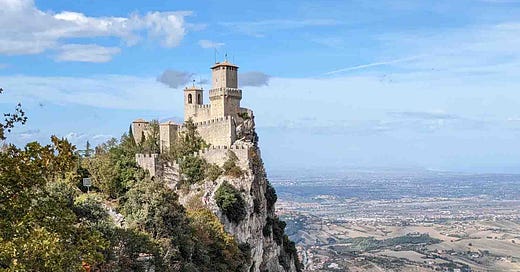


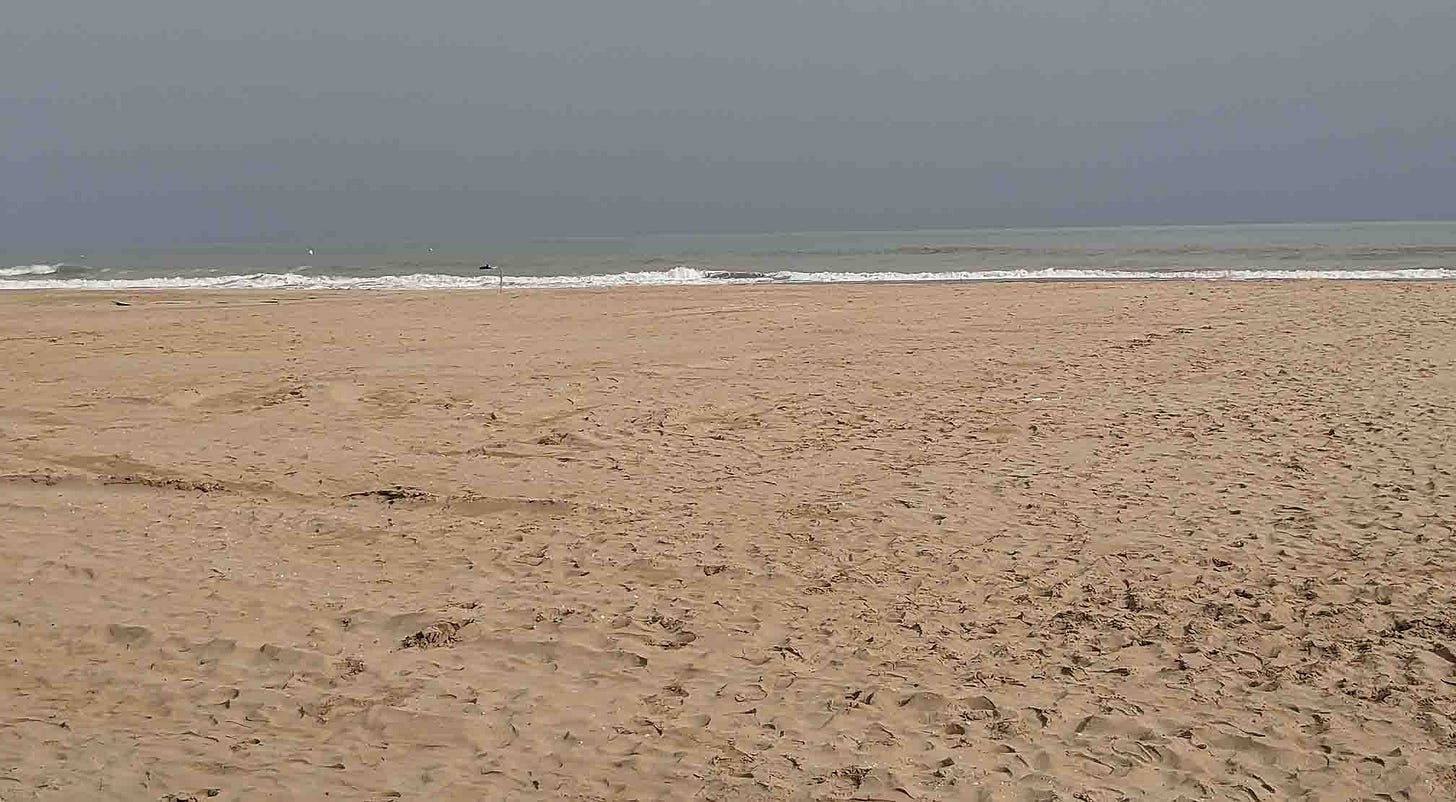
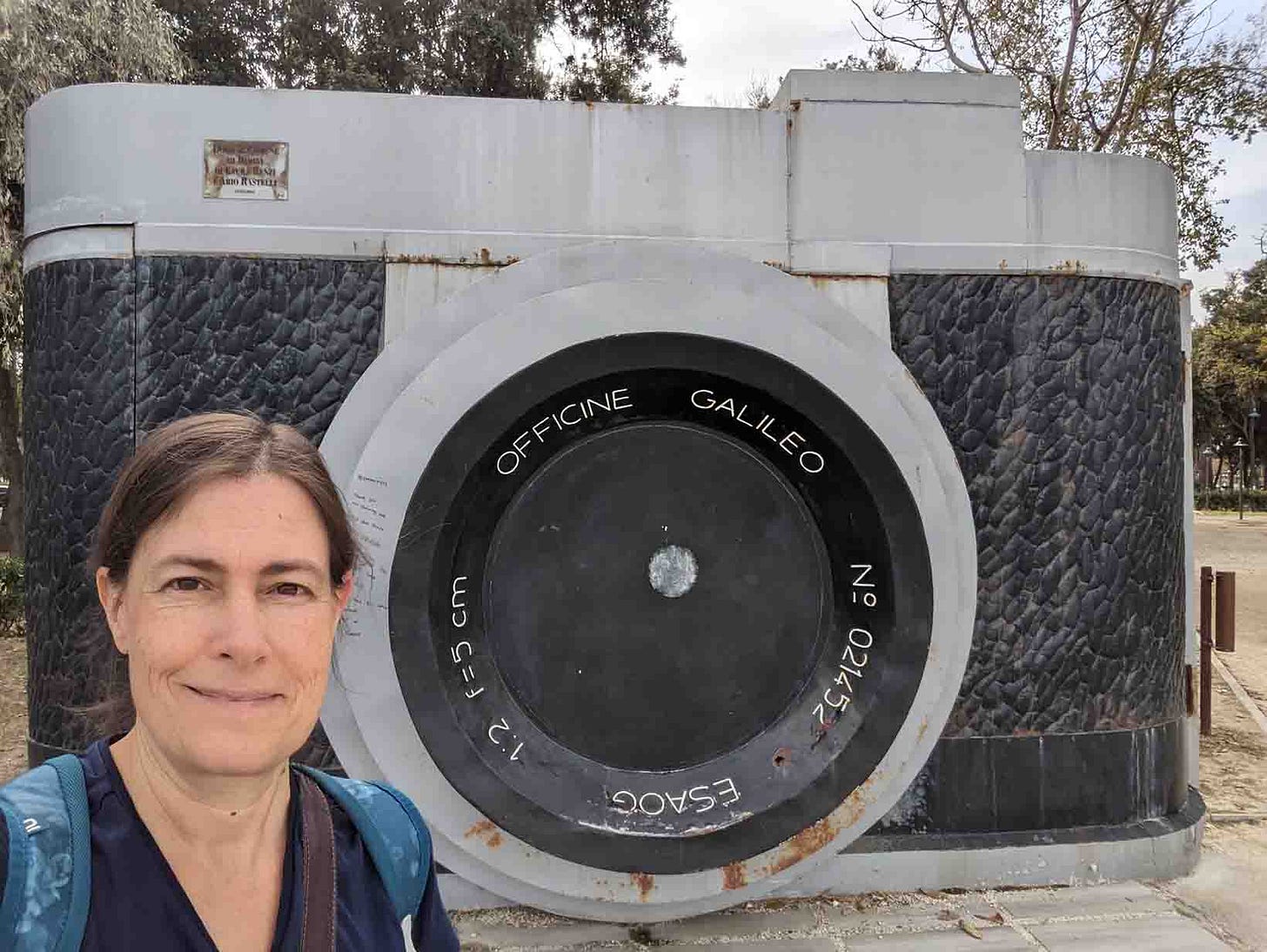
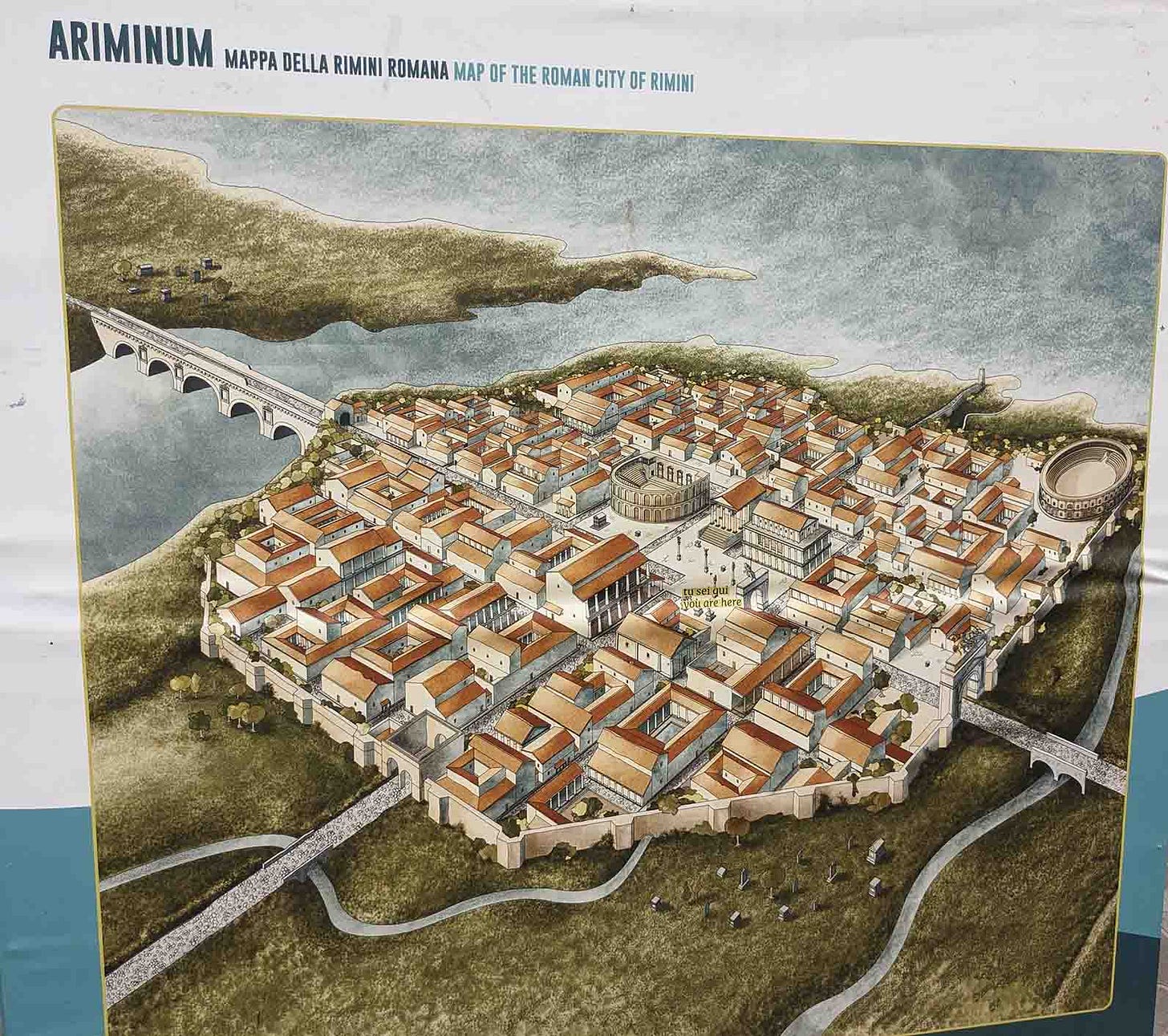
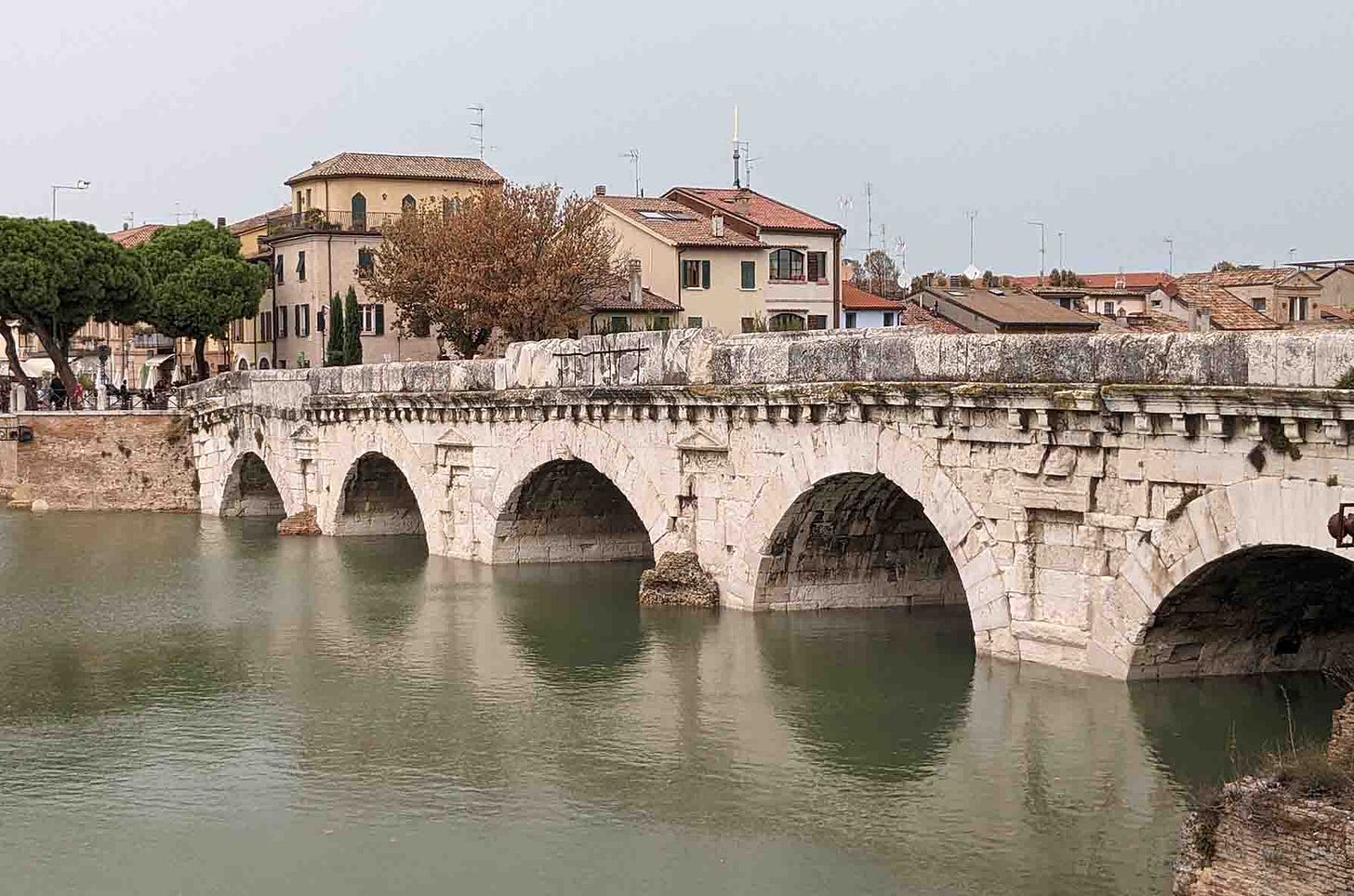
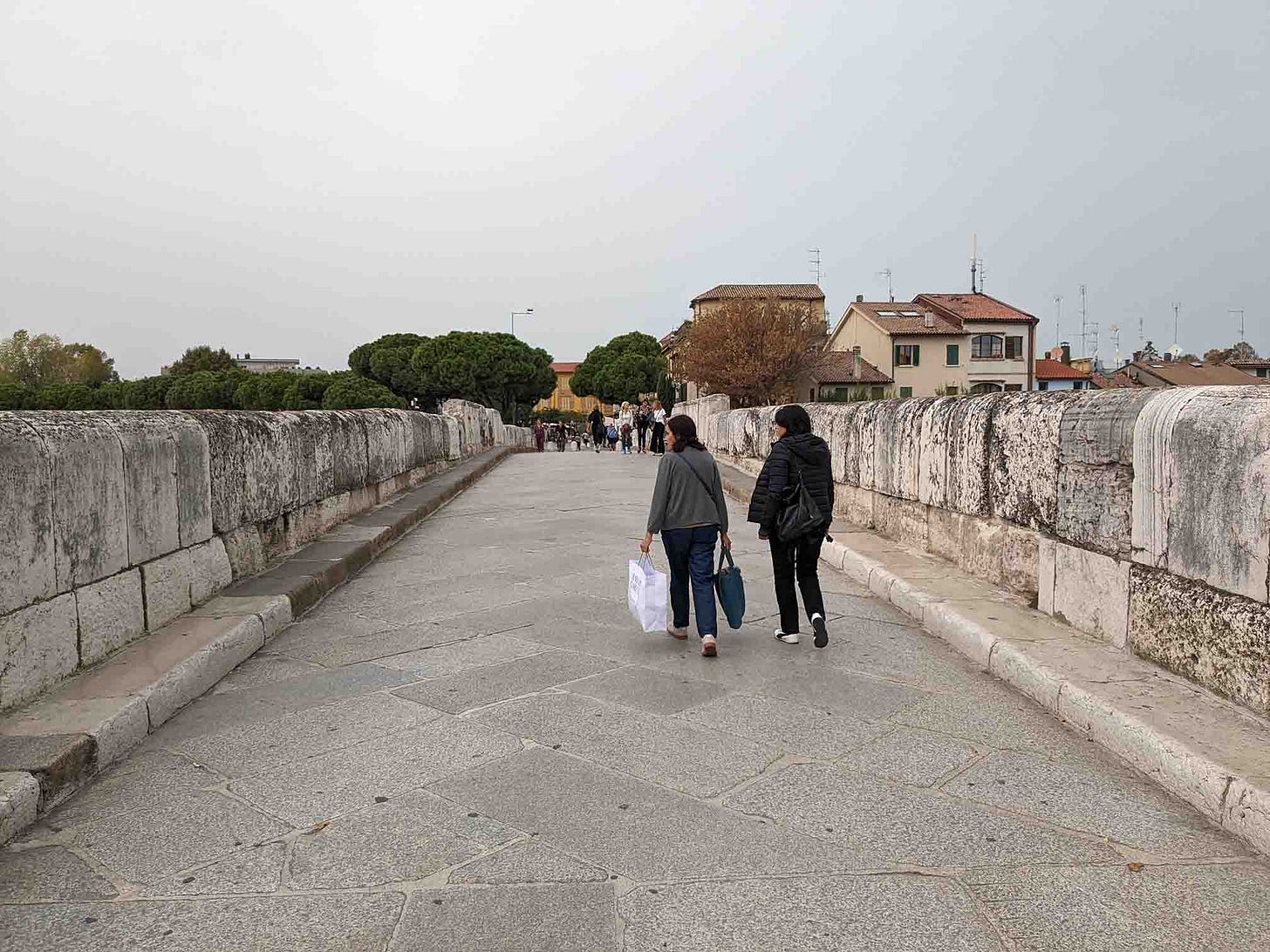
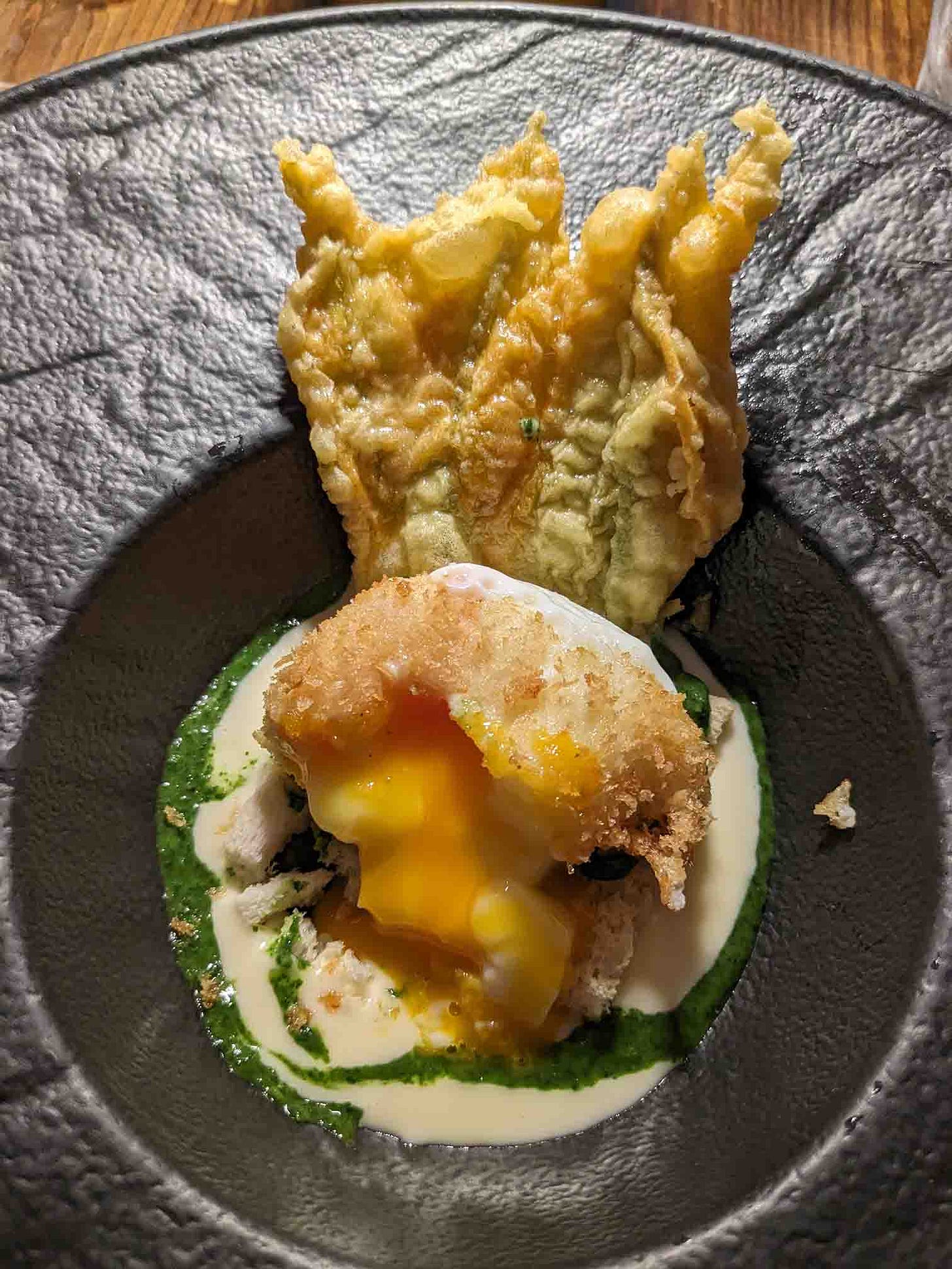
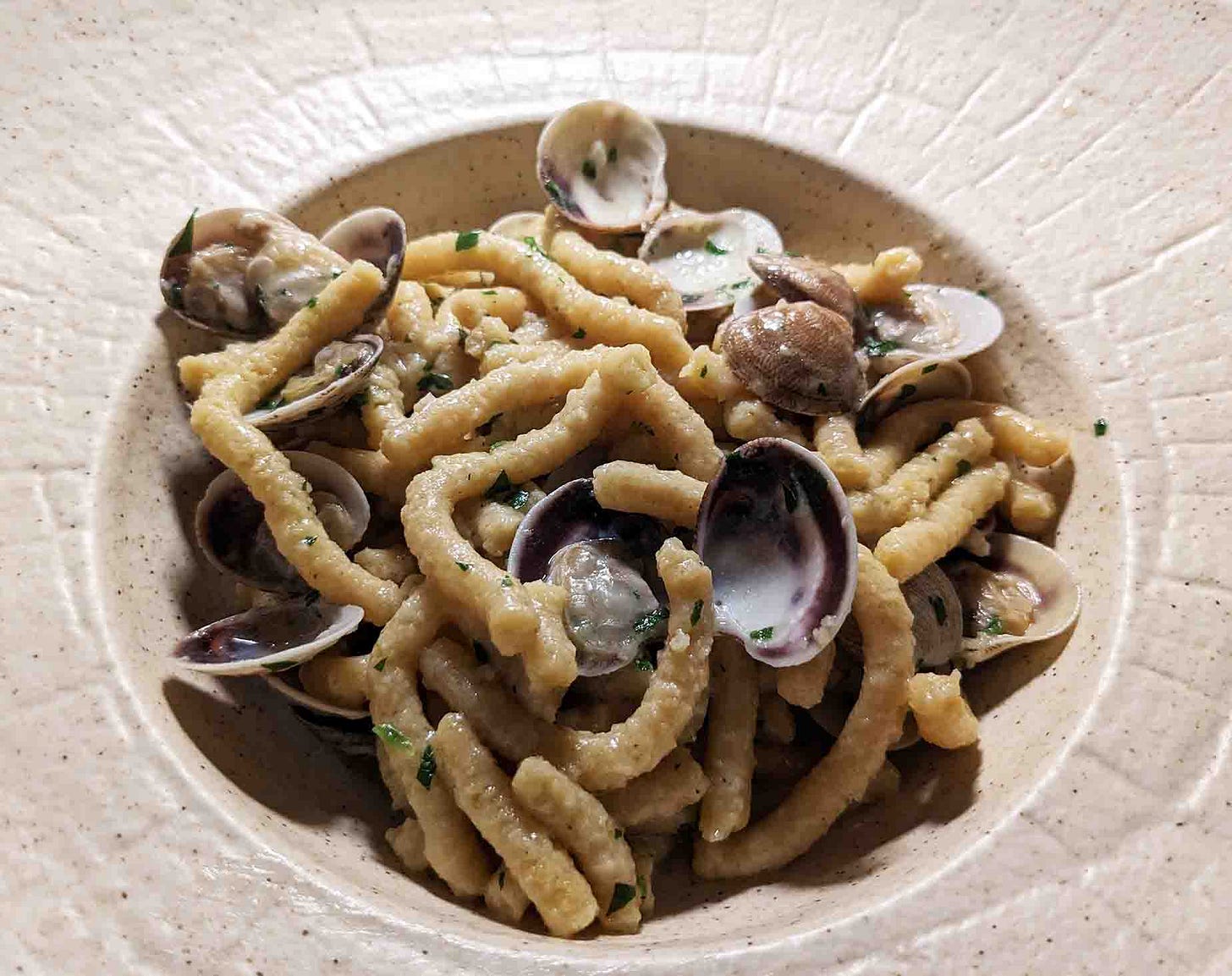

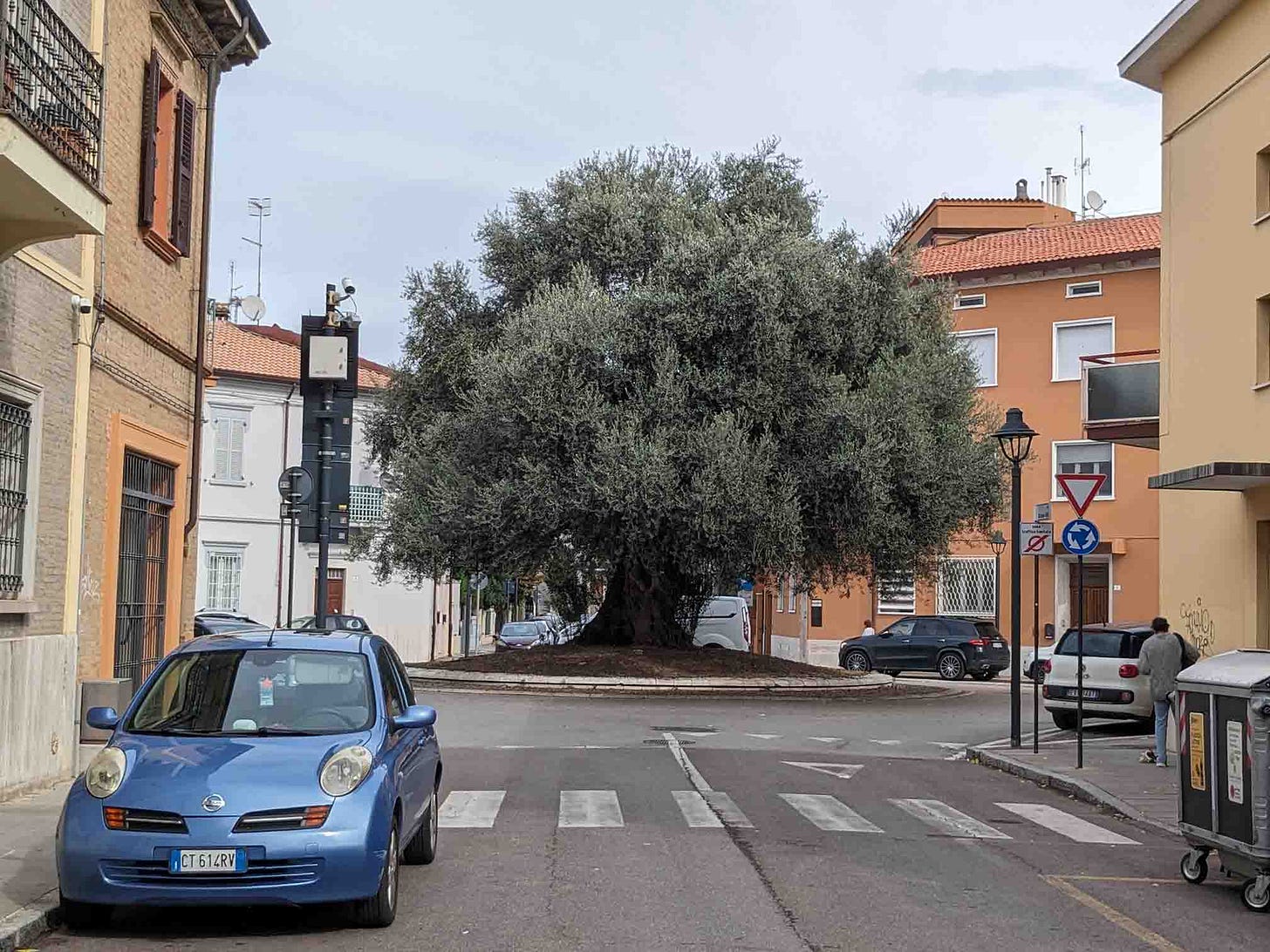
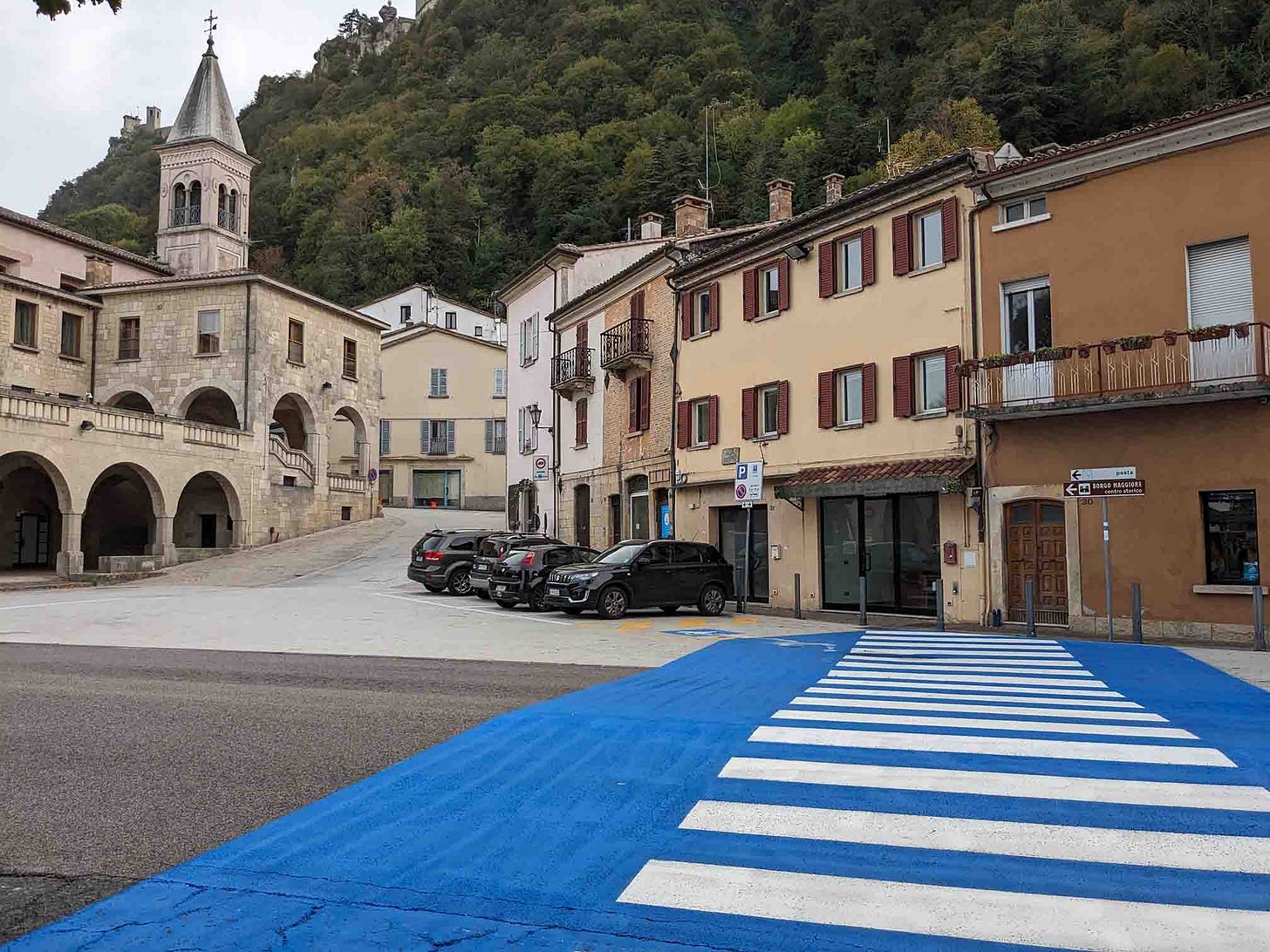
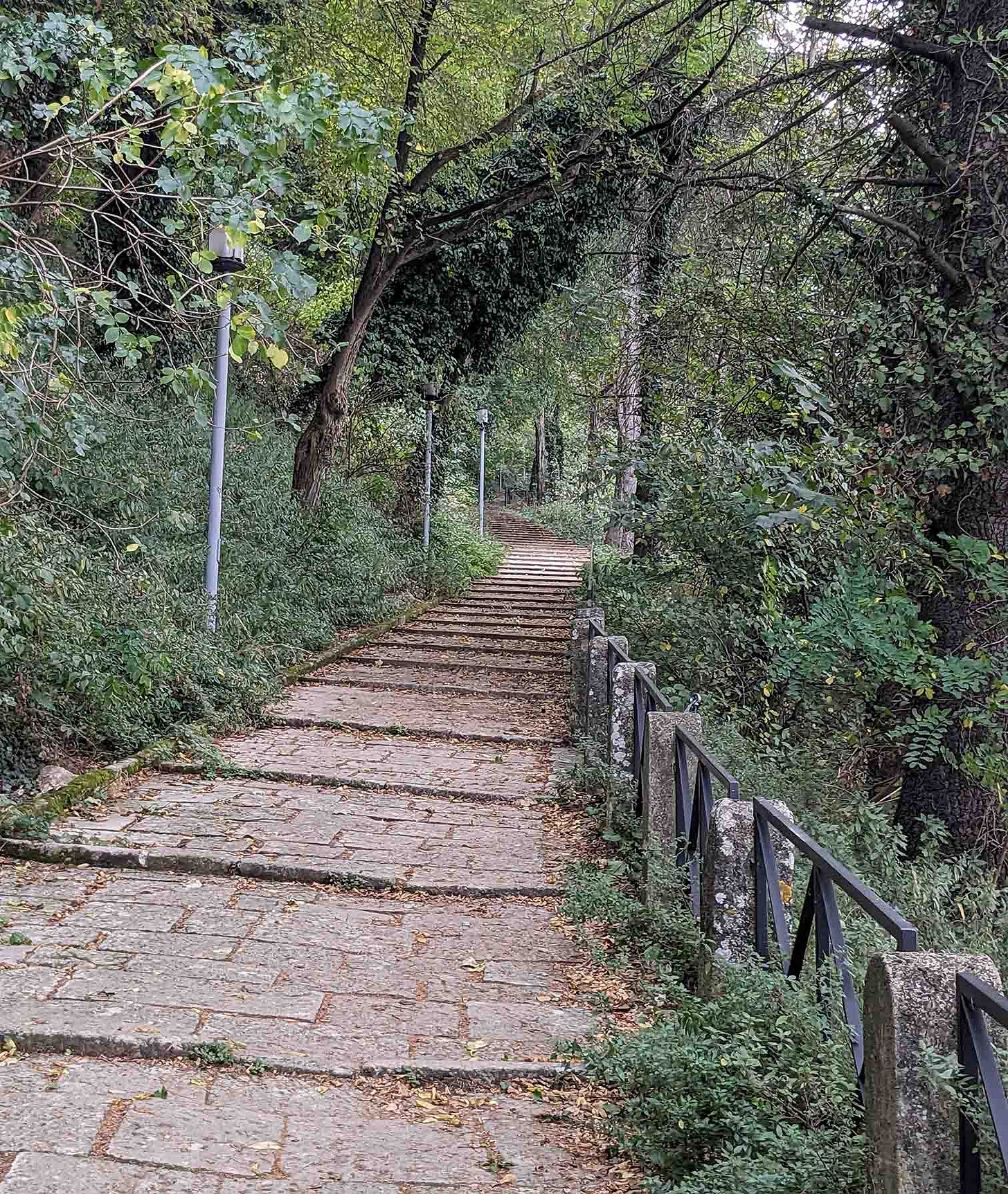
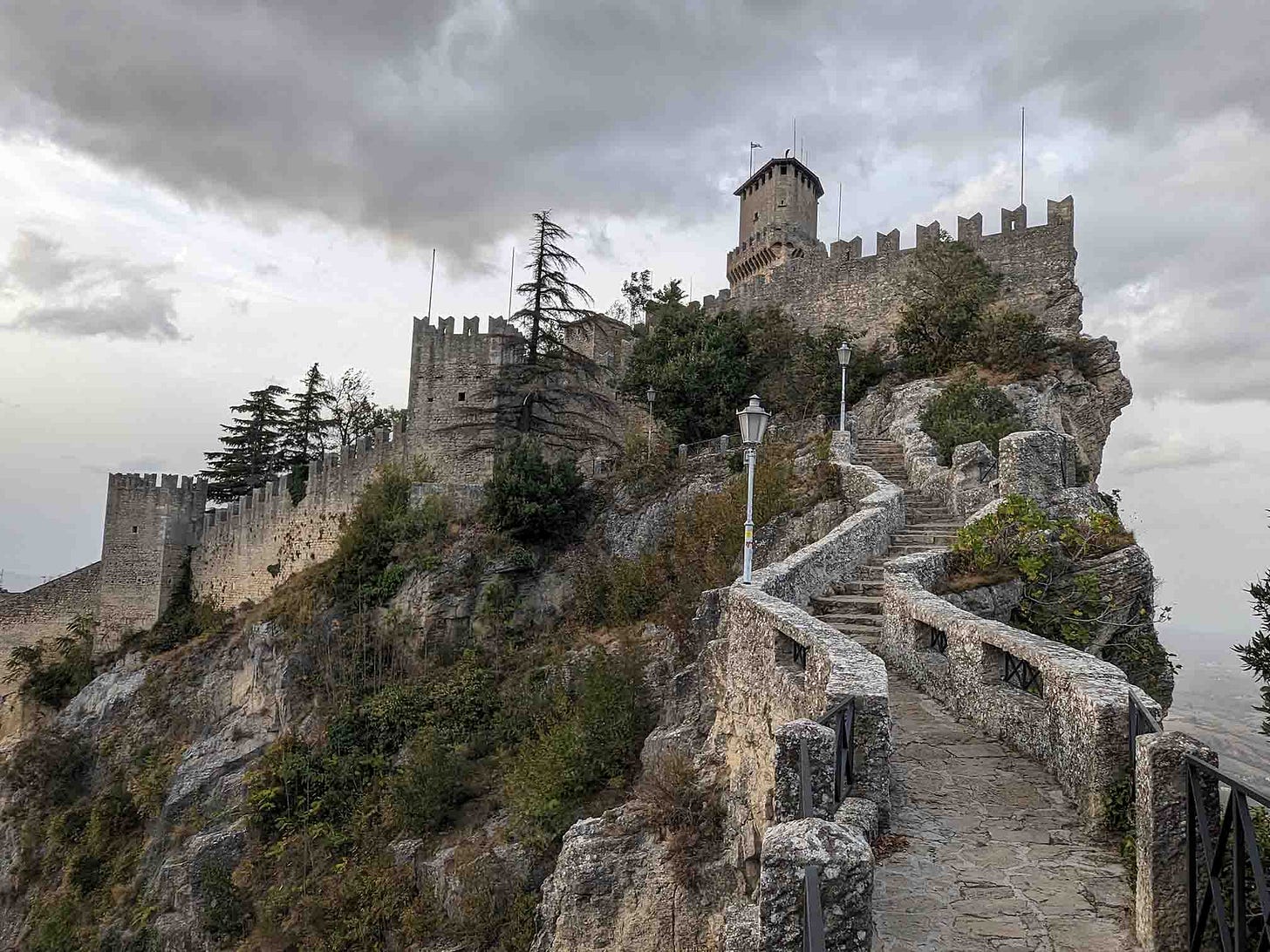
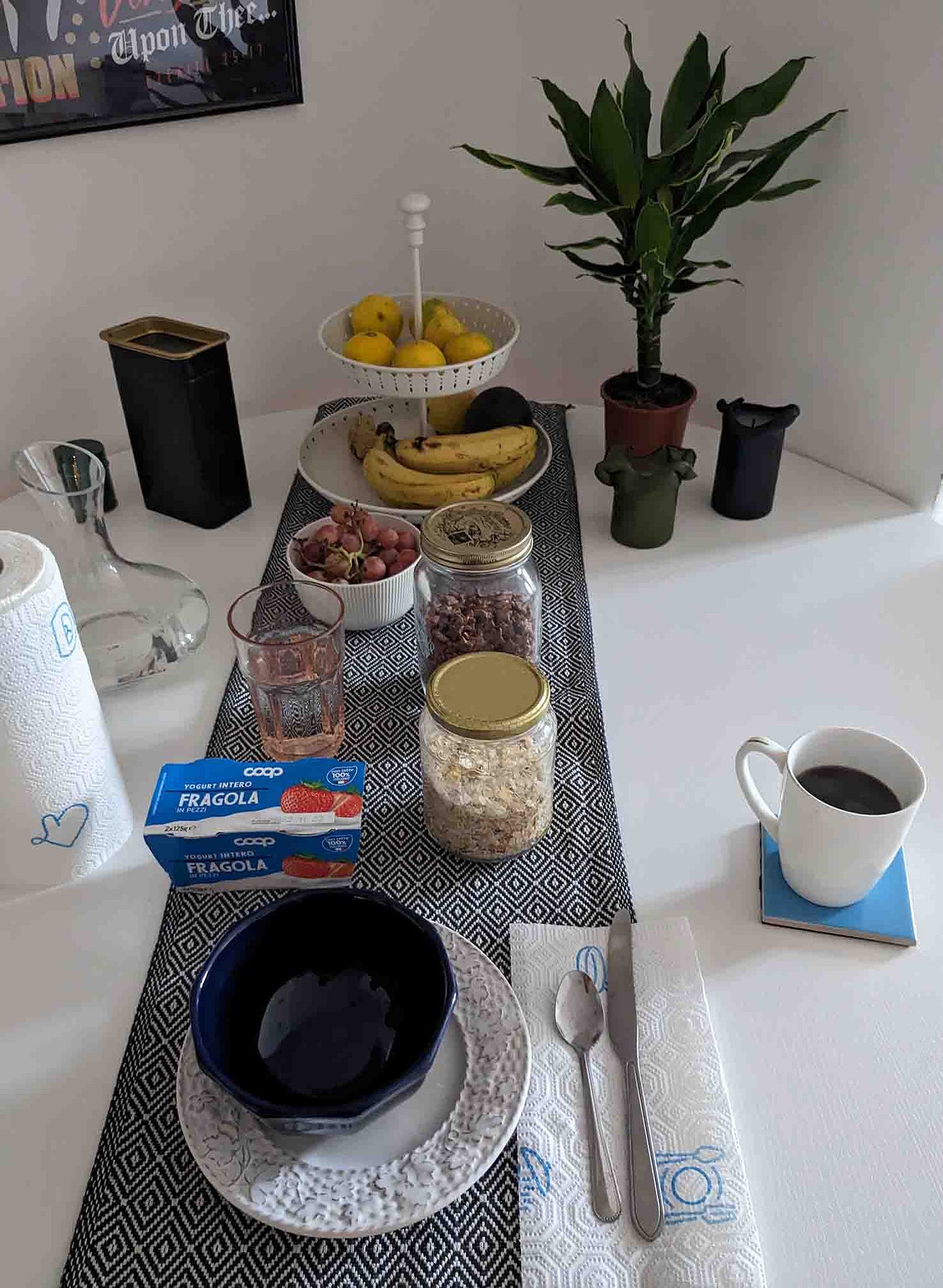
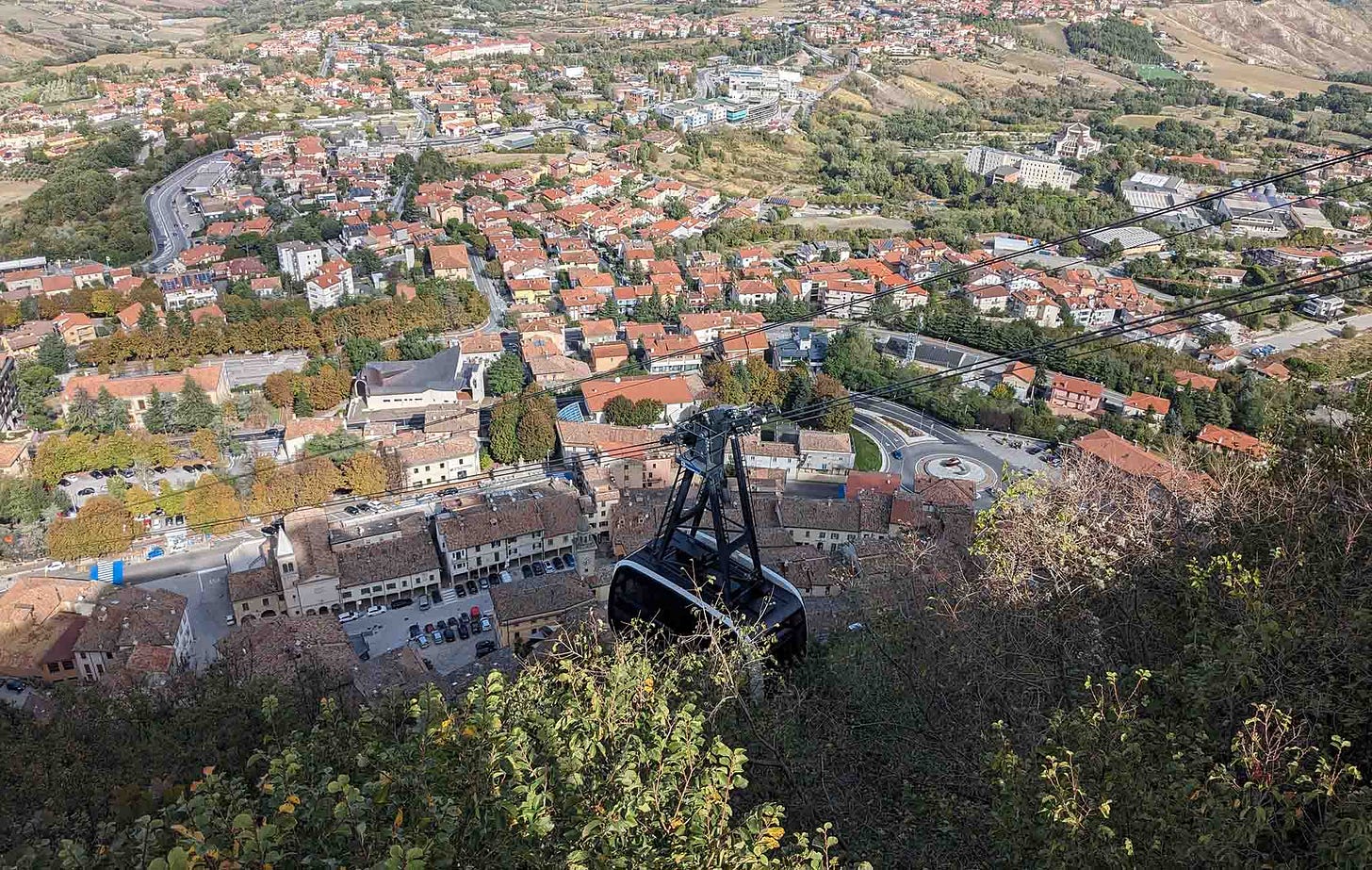
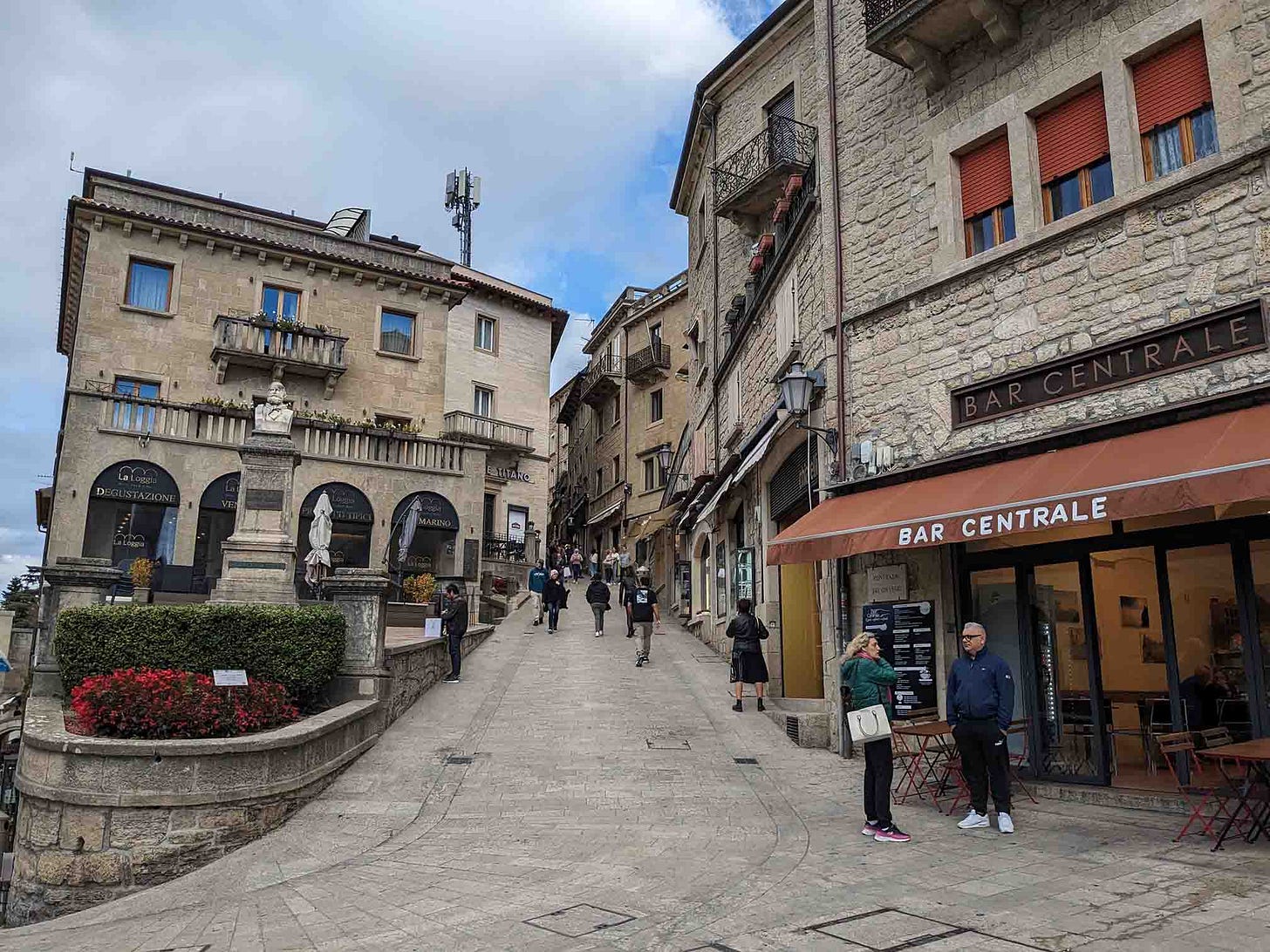
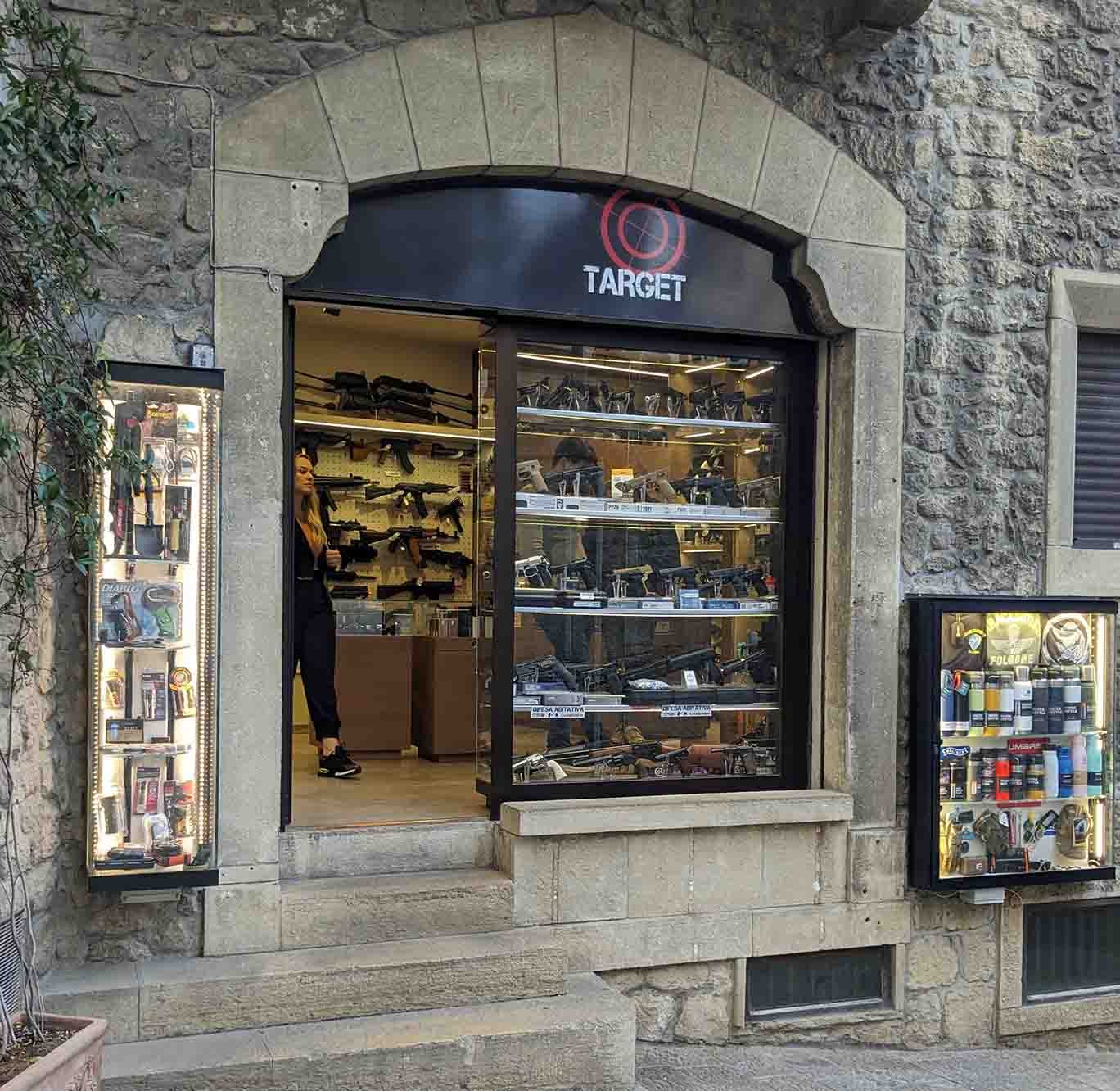
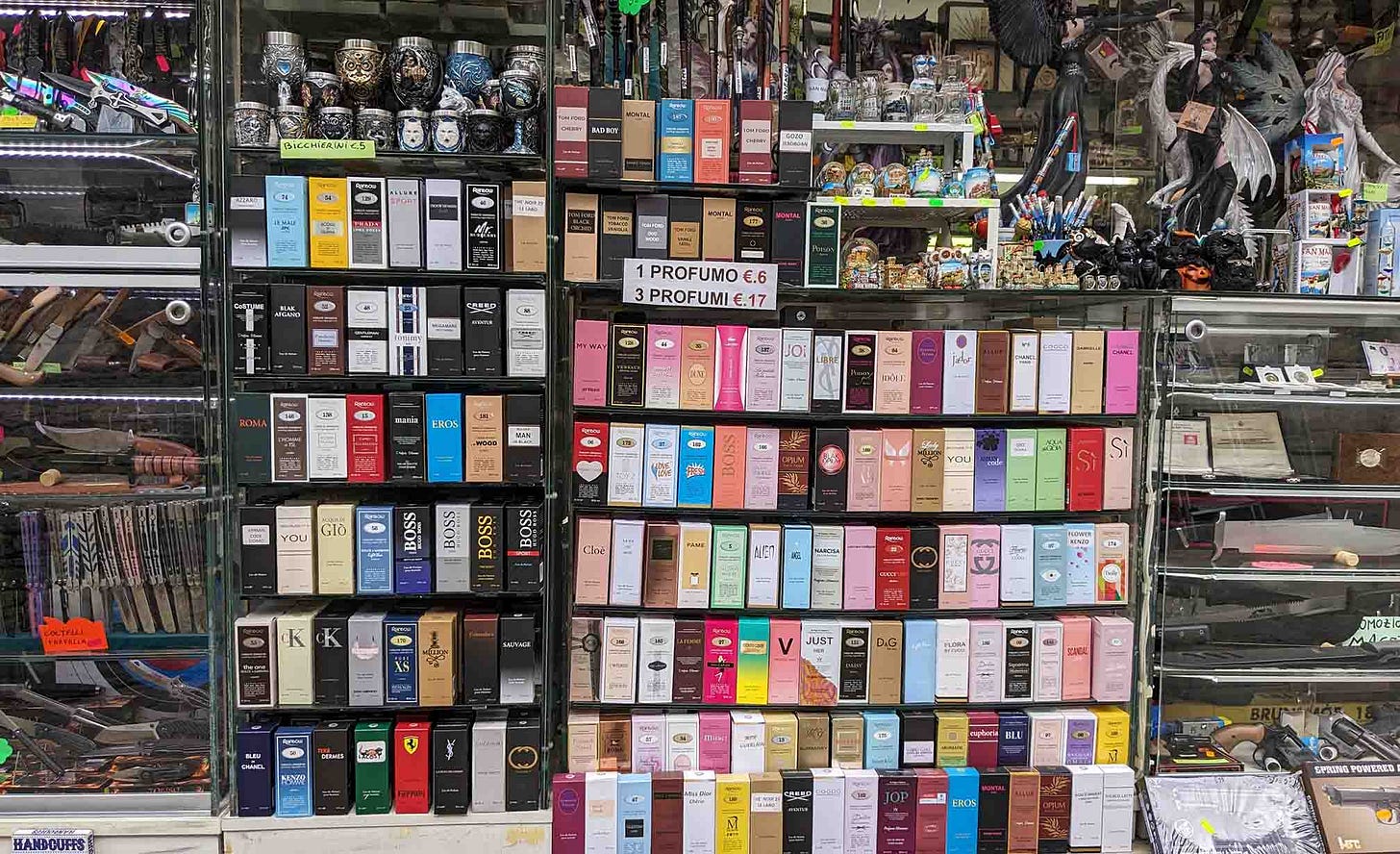

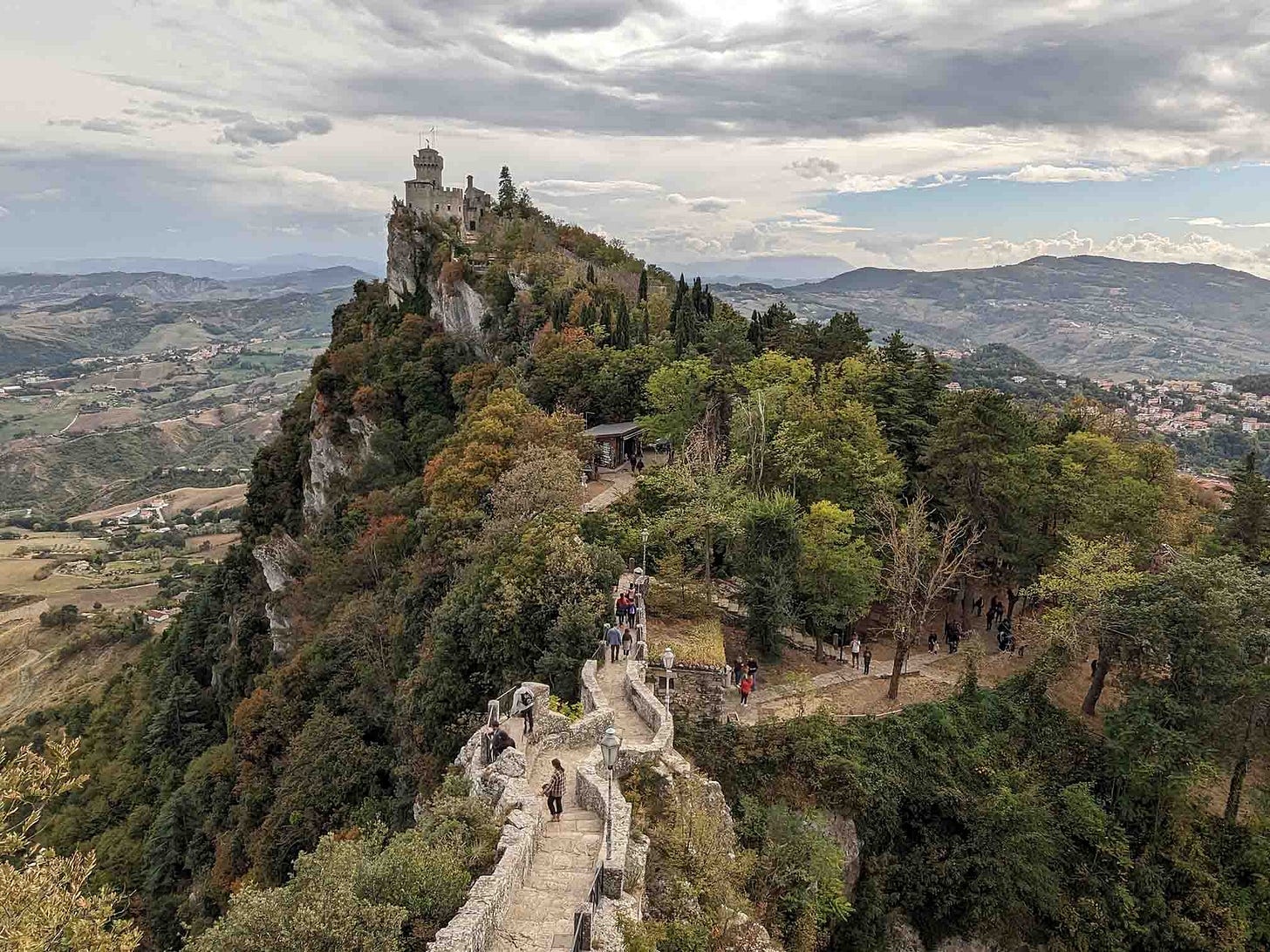


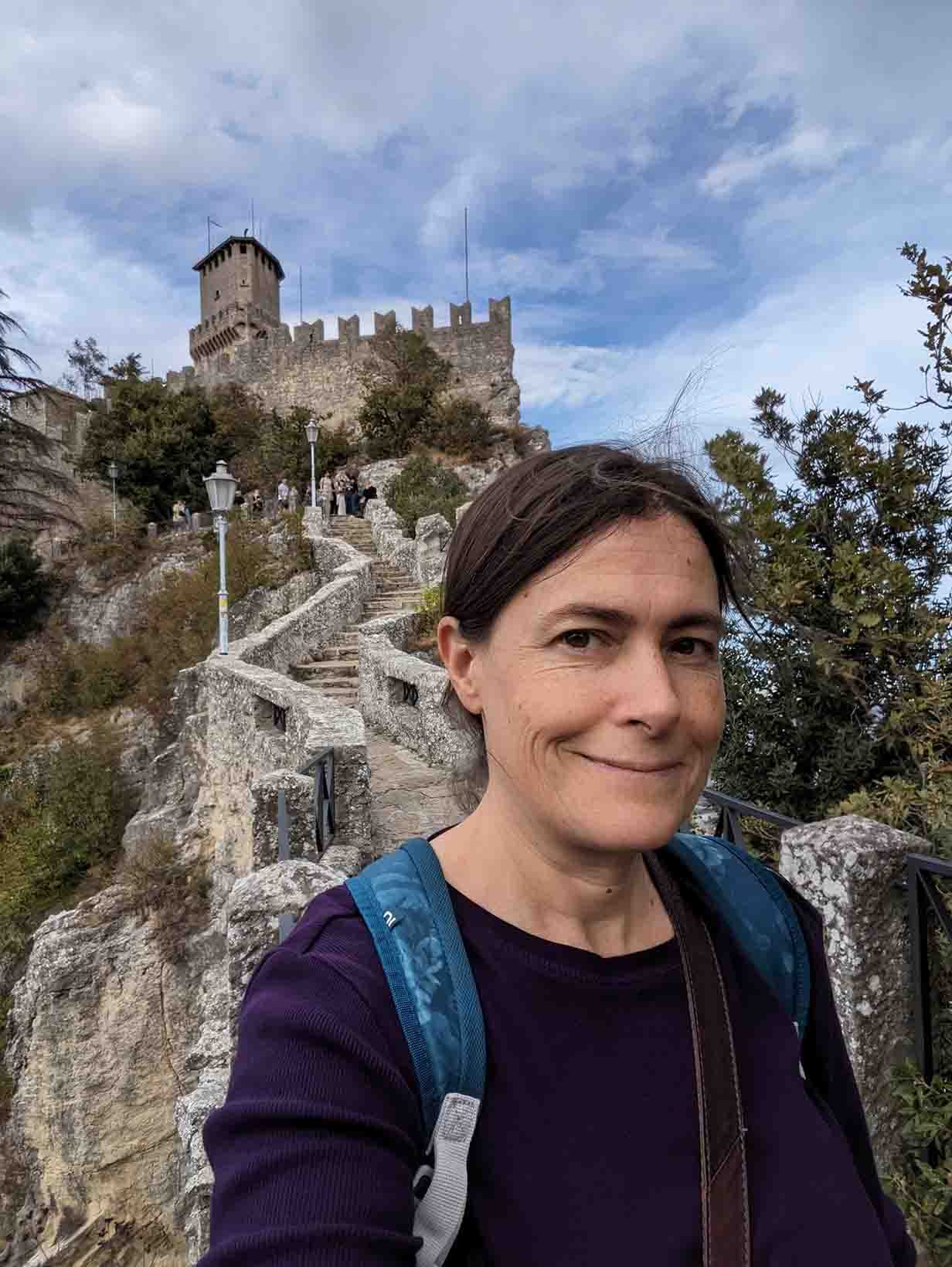

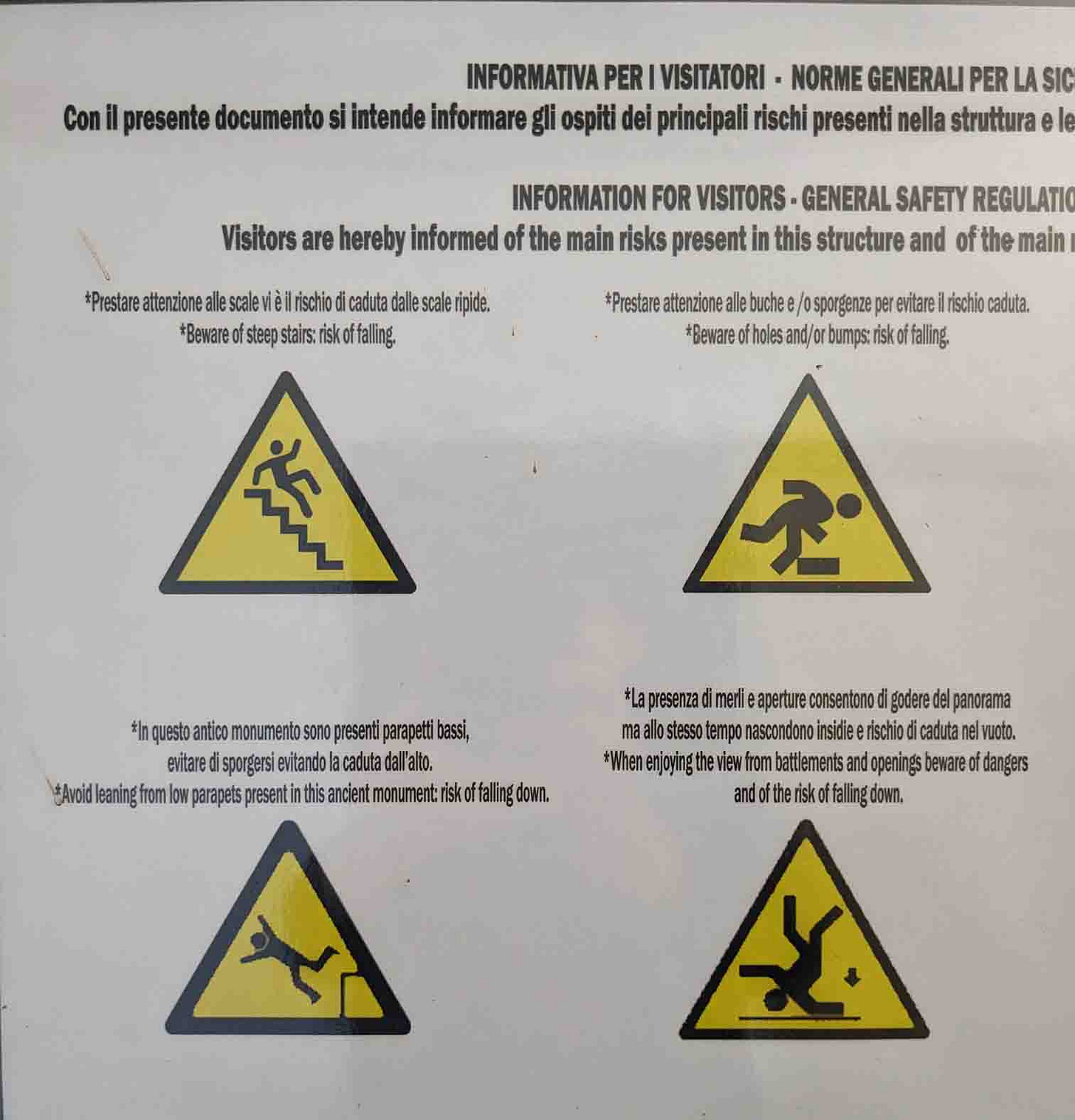
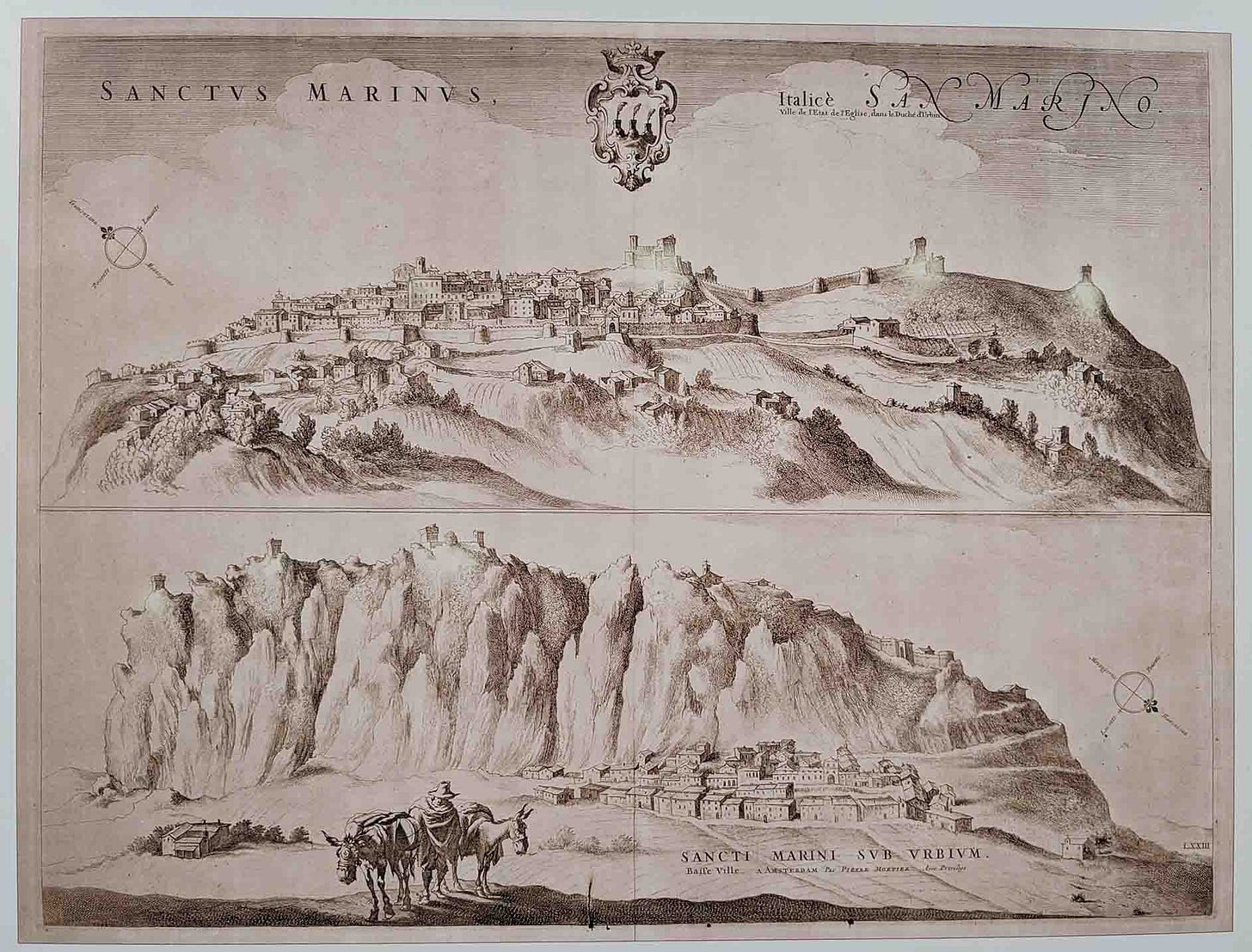
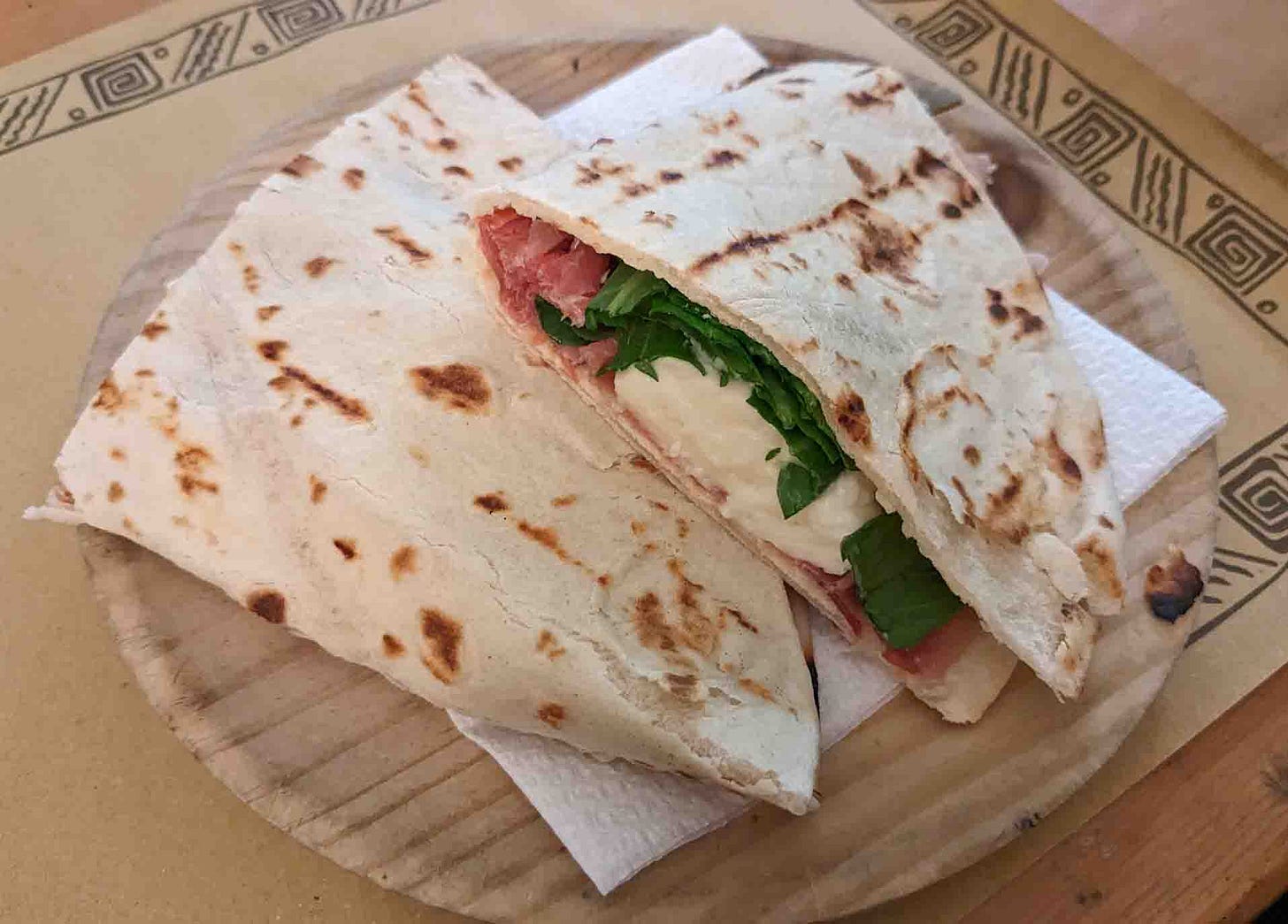

Thank you for the beautiful photos of landscapes, architecture, and foods. Now we need to visit Ramini and San Marino
I know this is mostly about food, and I know I could look this up easily enough, but I wanted to know how San Marino managed not to be absorbed into Italy the way every other microstate was. (In outlying parts of Piemonte, some folks still seem peeved about it)